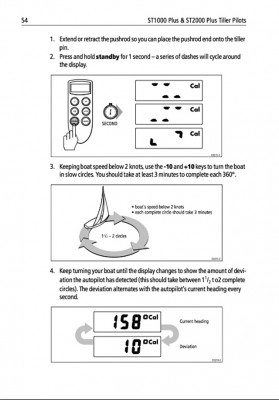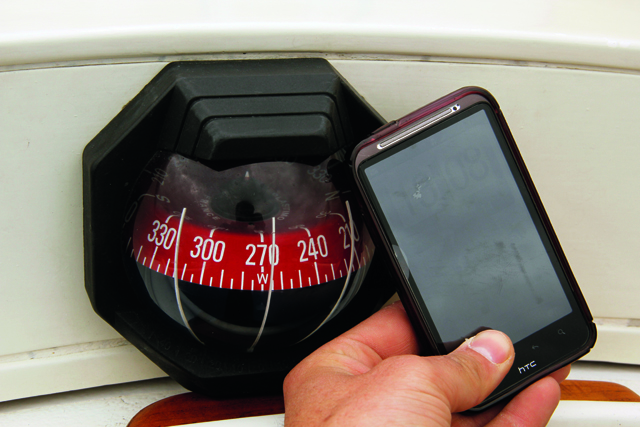The humble steering compass is still an important navigational tool. Here are some useful ways to check your compass is giving an accurate reading
Before GPS sets became so ubiquitous, swinging a compass was a yearly ritual for most boat owners, and the compass was the most important navigational tool onboard. After all, even a small error could have a major effect on an Estimated Position calculation. These days, we might not depend on them to the same extent, but the humble steering compass is still an important navigational tool. Compass adjusting is an art, and a short article can’t begin to cover all the techniques used by the professionals: but for here are some useful ways to check your compass is giving an accurate reading.
Using a chart
The traditional (and still the best) way is to use a paper chart to find a series of bearings and transits you can check your compass against. First, however, ensure there are no ‘local magnetic anomaly’ notices on the chart.
Find a series of transits and bearings that cover every section of the compass – the more you have, the better. Try to be on station at slack water, or else you’ll find lining up transits is tricky. Make sure everything is stowed in your ‘at sea’ position – anchor in chocks, dinghy engine in its usual place etc, to avoid any anomalous readings.
Before you head out, don’t forget to convert your true compass headings into magnetic by adding in the variation, which can be calculated using the figures normally printed inside the compass rose on the chart.
Using transits and leading lines
Transits are the obvious way to check the compass: we found a useful one in Southampton Water, off Netley Sailing Club. In addition to the charted transit, there were a series of useful transits around the daymarks. Netley Great Dome, daymarks on the western shore of Southampton Water and the Fawley power station chimney could provide us with a range of bearings. We had a slight issue in trying to steer across the tide, but as it slackened off near high water the readings became more accurate. We slowly motored the boat on each designated heading while monitoring the compass reading, noting it down in relation to the charted bearing. With this information we could then create a deviation card.
If you have a ‘dome’-style compass you can use a single transit, sighting across the compass to read the bearing as it lines up with the transit and slowly circling so that you read the bearing at all headings, thereby checking the deviation. The same can be achieved for a bulkhead compass by using a pelorus and comparing the readings.
Checking with a hand bearing compass
You can also use a hand bearing compass. Stand at the backstay and take a bearing of the mast, while someone else checks the steering compass on a variety of headings. If you’ve got a large crew on board, you can carry out all of this at once: point the boat towards a variety of transits while checking both the hand bearing and steering compasses. To ensure that items close to the backstay are not causing deviation in the hand bearing compass, compare a reading at the backstay with others taken from different parts of the boat before you start.
Using the GPS
While stationary, you can use your chart plotter to take a bearing of a nearby object which you can then verify with the compass. It’s a little crude, but it works – just check that your chart plotter is set to display magnetic degrees.
Allowing for deviation
Engines, tin cans, antennas and other metallic items on a boat can all affect a compass. That’s why it’s worth checking you haven’t stored tins near the fluxgate compass sensor, or that those new cockpit speakers aren’t too close to the tiller pilot. This is especially true with older gear, which often contains more metal than newer, mainly plastic items and may have a greater effect on your compass. It’s also worth checking for heeling error: as the relative position of the compass and engine shifts, the deviation may change. If you’ve been experiencing odd compass readings, do a check with the boat upright and heeled over on the same heading to double-check.
 Make a deviation card
Make a deviation card
With our readings obtained from the methods detailed above, we can make our own basic deviation card: you can download a useful blank template for free from www.cockpitcards.co.uk. Filled in and mounted near the chart table, it allows you to have an at-a-glance guide to deviation. For each heading, plot the error in degrees. You can interpolate if there is no reading for a particular heading. You don’t need to take all the readings at once, but if you can build up a comprehensive record during a cruise, you’ll have a useful guide. A deviation card may also help you track down a source of magnetic interference by showing you where to look.
This is only a basic guide to checking your compass – and if your results are way off, it’s worth getting a qualified compass adjuster in to inspect, swing and adjust the compass properly. But if it’s only a degree or so out, then you can refer to the deviation card when plotting a course to steer. Professional compass adjusters tend to only adjust a compass if its over 7-8 degrees out. On short trips you’ll find that a degree or so is well within a normal helmsman’s margin for error anyway!
Electronic Compasses
 You can set an electronic compass to swing itself, and remember the deviation that it encounters. Most will prompt you to perform two circles that take at least three minutes to complete, and then invite you to manually adjust the heading – which you can do so that it matches your steering compass. For that reason, it’s worth swinging the main compass first. If the electronic compass’s deviation figure is very high, carefully check that nothing magnetic is nearby before re-swinging it. A fluxgate compass won’t realise if anything changes though, unless you re-swing it – so it’s worth re-swinging it every year, just in case. If it’s a tiller pilot compass you’re swinging, ensure it’s in its ‘in use’ orientation first.
You can set an electronic compass to swing itself, and remember the deviation that it encounters. Most will prompt you to perform two circles that take at least three minutes to complete, and then invite you to manually adjust the heading – which you can do so that it matches your steering compass. For that reason, it’s worth swinging the main compass first. If the electronic compass’s deviation figure is very high, carefully check that nothing magnetic is nearby before re-swinging it. A fluxgate compass won’t realise if anything changes though, unless you re-swing it – so it’s worth re-swinging it every year, just in case. If it’s a tiller pilot compass you’re swinging, ensure it’s in its ‘in use’ orientation first.






